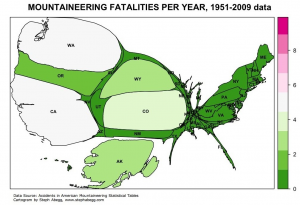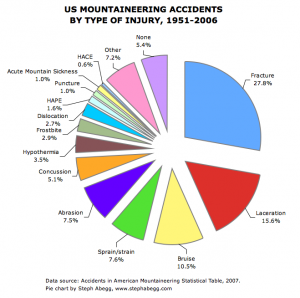The Deadliest Mountains
By Michael FaginK2 Weather, Karakoram Range Weather, Mt. Everest WeatherThe deadliest mountains claim dozens of lives annually. In the US May-September in California and Washington are the most deadly times and places to climb, composing about 40% of the US’ mountaineering fatalities. Colorado sees nearly half of California’s accidents. Alaskan injuries are on the rise due to increasing tourism.
Cause of Dealth

Mountaineering Fatalities Per Year 1951-2009
There are many causes of death while mountain climbing, such as mountain (altitude) sickness, internal or brain hemorrhaging, cerebral thrombosis, cerebral edema, cerebral apoplexy, by sliding seracs, snow and ice avalanches, by falling into a crevasse, other bad falls, perhaps from rope accidents, pneumonia, exposure to the elements possibly leading to organ failure, freezing conditions exacerbating previous illnesses, heart attack, pulmonary edema, stroke, cardiac arrest, exhaustion, starvation, by drowning in melted pools and lightning strikes. Very often, causes of death remain unknown.

Causes of Dealth
Deadliest Mountains
At the top of the list of Earth’s deadliest climbs is Annapurna – Nepal (26,545’), with a 32% fatality rate due to its sudden and frequent avalanches. Since Wanda Rutkiewicz’s successful climb in June 1986, K2 – Pakistan/China (28,251’), often called the “savage mountain,” has killed all five female climbers trying to reach the top. Known for its avalanches and being bitterly cold, Kanchenjunga – India/Nepal (28,169’) killed Rutkiewicz in 1992. Ninth highest in the world, the craggy Nanga Parbat – Pakistan (26,657’) has also taken the lives of many. The cliffs of Siula Grande, Peru (20,814’) have proven to be mountains of tasks to climb. Other notable mentions are the Matterhorn – Italy/Switzerland (14,691’), Everest – AK (29,029’) and Denali – AK (20,320’). Often mistaken for being safer, two more are Mt. Fuji – Japan (12,388’) and Mt. Washington – NH (6,288’).
I’m sure most mountain climbers know most of these facts and we sure we all realize that we are more likely to get hurt in a car accident than in climbing. Climbers are ten times more likely to die in a car accident at some point in their lives than when on climbing expeditions. Being injured in a car accident is 313 times more likely than being injured from climbing. We all climb safely looking at weather and route conditions and pick trained climbing partners. We also know why we climb. As a famous climber (George Mallory) once said: “because it’s there.”
Article written by:Meteorologist Geoff Linsley
Thanks to Accidents in American Mountaineering cartogram by Steph Abegg for many of the graphics.
